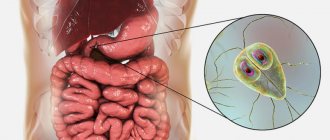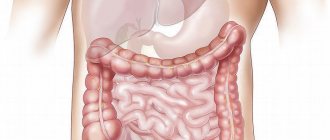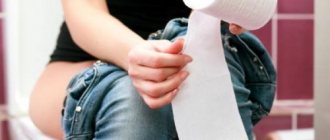Constipation
- a digestive disorder characterized by the absence of stool for more than two days or incomplete bowel movement.
According to medical statistics, today it is one of the most common phenomena, which is considered an independent disease by the World Health Organization. This fact may seem interesting, since a number of gastroenterologists consider intestinal constipation
a symptom of certain pathological conditions.
Be that as it may, constipation requires timely seeking professional medical help, as it can cause the development of serious proctological diseases. In itself, it affects the patient’s quality of life, significantly reducing it. At the same time, it is important for patients to know that the normal frequency of bowel movements varies from three times within 24 hours to three times a week (and not every day, as many believe). This must be taken into account when deciding to contact a specialist.
Causes of constipation
Constipation in adults
can develop for a number of reasons. Based on them, we distinguish:
- Primary constipation - can be congenital or acquired due to intestinal abnormalities;
- Secondary constipation - develops due to uncontrolled use of medications or due to diseases;
- Idiopathic constipation - occurs due to disturbances in the peristalsis of the large intestine, developing for unknown reasons.
It is worth noting that older patients suffer from constipation 5 times more often than younger ones. This occurs due to a decrease in the production of digestive enzymes by intestinal microflora as we age. As for other reasons, they are as follows:
- Poor nutrition, lack of clean water and dietary fiber;
- Polyposis, adhesions, structures, neoplasms of malignant etiology of the intestine;
- Frequent inhibition of the urge to defecate due to a heavy work schedule, long-distance travel, bed rest;
- Constant stress and psycho-emotional tension affecting bowel function;
- Regular use of laxatives due to the fact that the patient mistakenly believes that bowel movements should occur every day;
- The presence of anal fissures and hemorrhoids, causing severe pain during defecation and causing fear of it.
New possibilities for drug therapy for chronic constipation
Speech by Professor Arkady Aleksandrovich Sheptulin , who presented new developments and possibilities of drug therapy for chronic constipation.
00:00
Vladimir Trofimovich Ivashkin , academician of the Russian Academy of Medical Sciences, Doctor of Medical Sciences:
“Now I pass the opportunity to speak to Professor Arkady Aleksandrovich Sheptulin, who will continue this line of reasoning and talk about new possibilities for drug therapy for chronic constipation.
Arkady Aleksandrovich Sheptulin , Doctor of Medical Sciences, Professor:
— Good afternoon, dear colleagues.
I will start with the relevance of the problem discussed today. Note the high prevalence of constipation, which reaches 20% among adults and 30-40% among people over 60 years of age. Up to 3% of all consultations for young children and the elderly are for constipation.
In the US, this amounts to about 6 million consultations per year. Direct costs for treatment and examination of patients with constipation in the United States reach 10 billion dollars.
It is important that data on the prevalence of constipation reported in the literature are underestimated. At least 2/3 of patients do not seek medical help and independently resort to taking laxatives from the group of over-the-counter drugs.
Constipation is often accompanied by other clinical symptoms (bloating, straining during bowel movements, pain during bowel movements, false urges). As a result, the quality of life of patients with chronic constipation decreases. It turns out to be the same as in patients with rheumatoid arthritis and diabetes mellitus.
One cannot help but mention the lack of effectiveness of existing treatment methods. More than 70% of patients in European countries are not satisfied with the results of treatment. More than 80% of patients with chronic constipation would like to know more about new drugs to treat them.
For us, especially for the staff of the Department of Propaedeutics and Internal Medicine, it is important that chronic constipation is not an independent disease. At the initial stage, they can be divided into two large groups. These are patients with primary (ideopathic and functional constipation) and patients with secondary constipation.
A large and diverse group of patients with secondary constipation. These are patients with organic intestinal lesions, colorectal cancer, strictures due to chronic inflammatory bowel diseases, and external intestinal pressure. Endocrine and metabolic diseases (diabetes mellitus - diabetic intestinal pseudo-obstruction syndrome, hypothyroidism).
Neurological causes (Hirschsprung's disease, Parkinson's disease, multiple sclerosis). These are lesions of the intestinal wall - myogenic constipation in scleroderma, dermatomyositis. These are anorectal constipation with anal fissures and proctitis.
03:21
If we talk about primary constipation, then their criteria are considered in the light of the Rome criteria for functional disorders of the gastrointestinal tract (GIT). A synonym for primary constipation is the more familiar term “functional constipation”.
We can talk about them when patients have a hard consistency of stool in the form of nuts, when patients experience tension during the act of defecation, a feeling of obstruction in the anorectal area. When they resort to manual manipulation to facilitate the act of defecation.
It is very important that constipation is said to occur when the frequency of bowel movements becomes less than three per week. If two of the above symptoms are present, a diagnosis of functional constipation can be made.
According to the Rome criteria (III), the fundamental sign of chronic constipation is a change in stool consistency in accordance with the Bristol scale. It is noted that this scale is easily understood by the patient and helps to identify constipation in cases where the frequency of stool remains normal.
If we talk about primary or functional constipation, then these include patients with irritable bowel syndrome (this is a variant with a predominance of constipation). This is functional constipation, as an independent category of functional disorders. These are constipation associated with dyssynergia of the pelvic floor muscles (spasm of the anal muscles, impaired relaxation, decreased sensitivity of rectal wall receptors to stretching).
05:00
At the stage of diagnosis, the main thing is to exclude the secondary origin of constipation. Patients who contact us are required to undergo laboratory tests, stool analysis for occult blood, digital examination of the rectum, sigmoidoscopy, and colonoscopy. According to indications - plain radiography of the abdominal organs, irrigoscopy, computed tomography with contrast of the intestine.
If organic diseases and obstructive intestinal lesions are excluded, then the most likely explanation for the causes of constipation is functional disorders.
For gastroenterologists, it is important to distinguish between irritable bowel syndrome (a variant with a predominance of constipation) and functional constipation. In fact, there are very few differences between these concepts.
It is no coincidence that I have now quoted European recommendations for the treatment of constipation. It can be very difficult to distinguish between chronic functional constipation and irritable bowel syndrome with a predominance of constipation, since there is often an overlap of clinical symptoms.
The American College of Gastroenterologists recommends talking not about functional constipation, but about IBS with constipation, when patients have discomfort along with constipation. Let's ask any patient with constipation: “Are you experiencing discomfort?” Of course, the patient will answer: “What discomfort I am experiencing.”
There are very few differences between functional constipation and IBS constipation. Having dealt with this problem, I can say that the principle of treatment for both IBS with constipation and functional constipation is the same. The drugs used in their treatment and the gradation of their administration are the same.
Let's consider the treatment of chronic constipation from the perspective of evidence-based medicine.
(Slide show).
The evidence base is determined by capital letters of the alphabet. Good – level A. Moderate – level B. Weak evidence base – level C.
In parallel with the level of evidence, the quality of the studies conducted is assessed. The first level is considered to be the quality of studies that were randomized multicenter. The second level is cohort and case-control studies.
The lowest third level of research is the opinions of experts and scientists based on their personal observation.
07:57
Treatment of constipation begins with dietary recommendations. These include enriching the diet with wheat bran. It is believed that the effect will be when prescribed at least 20 g per day.
12 studies published. Most of them are 15 years old. This indicates that the interest of scientists in dietary fiber is quite low, because patients’ adherence to treatment is low.
About 50% of patients who are prescribed wheat bran stop taking it on their own due to increased flatulence. The quality of research on the effectiveness of dietary fiber is not very high. The only exception here is Psyllium. This is a preparation that contains empty cell walls of Plantago ovata.
Psyllium has confirmed the effectiveness of controlled studies. It is recommended by the American College of Gastroenterologists for the treatment of functional constipation and IBS constipation.
List of laxatives. This is the next step in the treatment of constipation. Currently, two large groups of laxatives remain:
- - irritating effects (anthraquinones, bisacodyl, sodium picosclate);
- - osmotic laxatives (polyethylene glycol or macrogol and lactulose).
When characterizing laxatives, it should be noted that most studies on their effectiveness are based on a small number of observations. There are no studies on the comparative effectiveness of individual groups of laxative drugs among themselves. So-called “head-to-head” studies.
There are no studies on the effect of laxatives on quality of life. However, it is most often recommended to start treatment with osmotic laxatives. They actually increase the frequency of bowel movements in patients from two to five per week.
The effectiveness of osmotic studies has been proven in placebo-controlled studies, including long-term use of up to 12 months and use in pediatric practice.
10:28
When assessing effectiveness, I used two sources. This is the American College of Gastroenterologists, which assessed the effectiveness from the perspective of evidence-based medicine. The second is the American College of Coloproctal Surgeons. The evidence for the effectiveness of polyethylene glycol and lactulose is highly rated.
As for irritating laxatives (anthraquinone, bisacodyl, sodium picosclate), the evidence of their effectiveness is lower. It has been confirmed only by a few placebo-controlled studies. The general assessment of their effectiveness is level B and C.
A significant proportion of patients with chronic constipation are not satisfied with the results of using laxatives. A quarter of patients note the lack of predictability of their actions. With the same dose of the drug today you can get no effect, but tomorrow you will have diarrhea.
Indeed, diarrhea with cramping pain and flatulence is a very common side effect of laxatives.
Electrolyte disturbances (hypokalemia) are possible, as a result of which intestinal peristaltic activity decreases and a vicious circle occurs. We prescribe laxatives, and hypokalemia occurs. It further aggravates the presence of constipation.
While taking laxatives, degenerative changes in the cells of the Meissner and Auerbach plexuses are possible. This happens during therapy with anthraquinones, which also then aggravate motor impairment. Stimulant laxatives are not recommended for use for more than two weeks.
Anthraquinones cause staining of the intestinal mucosa (melanosis). We all know well that, having started taking laxatives, patients are forced to continue to increase their dose very often, as the addictive effect develops (lazy bowel syndrome).
12:48
At one of the symposiums on the treatment of diarrhea during the last European Week, the chairman began by saying that for many patients, chronic constipation is an important problem given the reduced quality of life, as well as resistance to general measures and laxatives.
What new drugs have been proposed for the treatment of chronic constipation? This is "Lubipriostone". This is a drug that belongs to bicyclic fatty acids and promotes a dose-dependent increase in the secretion of chlorides in enterocytes and colonocytes.
Lubiprostone is approved in the United States for the treatment of chronic functional constipation. Later for the treatment of IBS with constipation in adults. The overall assessment of the effectiveness of Lubiproston is very high. But the drug has not yet been registered in European pharmaceutical markets. It is not used in European countries and our country.
The second drug that is proposed is “Linaclotide”. It is a guanylate cyclase C agonist that stimulates water secretion in the intestine. Accelerates the transit of contents through the intestines.
The results of the third phase of randomized controlled trials have now been published. They showed an increase in stool frequency, an improvement in the quality of life, and the absence of the “rebound” phenomenon. But a fairly high frequency of side effects is diarrhea.
In European countries, Linaclotide is also not licensed.
A separate group of drugs consists of 5-HT4 receptor agonists. Their stimulation in the intermuscular nerve ganglia of the intestine leads to the release of acetylcholine and to increased propulsive motor activity.
Various representatives of this class of compounds. "Mosapride" and "Renzapride" can be immediately excluded. They did not live up to the expectations placed on them. There are three drugs left: Cisapride, Tegaserod and Prukaloprid.
Those of you who have been working in gastroenterology for more than 15 years probably remember how a ban appeared on our domestic market in the late 1990s. It was Coordinax, which showed high effectiveness in the treatment of patients with IBS with constipation. But due to side effects (prolongation of the Q-T interval and a high risk of developing ventricular arrhythmias, sudden cardiac arrest), this drug was discontinued in 2000 and withdrawn from circulation.
15:44
Its niche was filled by Tegaserod. This drug has received very good press. A meta-analysis of the results of its use in more than 9 thousand patients with IBS with constipation was conducted. It has shown very high effectiveness, especially in women.
However, in 2007, the results of using Tegaserod in a very large group of patients were reviewed. They were compared with a large control group. It was found that the incidence of cardiovascular complications (mostly middle-aged women) in the main group (even though there were few such cases in absolute terms) in relative percentage terms was 11 times higher than in the control group. We are talking about the frequency of myocardial infarction and strokes.
The drug was withdrawn from circulation that same year.
A new representative of the 5-HT4 receptor agonist “Prucalopride” has attracted interest. In Invitro studies, it was 150 times more selective than Cisapride. It has been shown that Prucalopride has a positive effect not only on stool frequency, but is also able to eliminate other symptoms associated with constipation (bloating and pain).
Evaluation of the clinical effectiveness of Prucalopride. In our country it is registered under the name “Rezolor”. In clinical studies, the majority were women. But this is not due to the fact that the drug is effective only in women. Rather, it reflects population differences in incidence between men and women.
Good results have been obtained from using Prucalopride in men. It is believed that this year the use of Prucalopride will be allowed not only in women, but also in men and even in children.
What were the parameters for assessing the effectiveness of Prucalopride? This effectiveness was assessed according to three parameters:
- — the relative number of patients in whom normalization of stool frequency was achieved during treatment was determined;
- — the relative number of patients whose frequency of bowel movements increased by more than one act per week during treatment was assessed;
- — the relative number of patients whose quality of life improved by more than one point was assessed.
18:38
After a course of treatment (its duration was from 4 to 12 weeks), the normalization of stool frequency in patients receiving Prucalopride at a dose of 2 mg/day and 4 mg/day was 2 times higher than in patients receiving placebo. These differences were statistically significant.
The same applies to the number of patients who achieved an increase in the frequency of bowel movements by more than one per week. In patients receiving Prucalopride, this frequency was almost 2 times higher than in patients receiving placebo.
More than 40% of patients receiving Prucalopride showed an improvement in quality of life.
The results of eleven double-blind, placebo-controlled studies of the effectiveness of Prucalopride in patients over 65 years of age were analyzed separately. After 4 weeks of treatment at doses of 2 and 4 mg/day, normal stool frequency was achieved in 30% of patients. An increase in the frequency of stools by almost one per week – in more than 40% of patients. The same number of patients showed an improvement in quality of life.
The greatest effectiveness of Prucalopride was noted when it was used in daily doses of 2 mg. In elderly patients and in patients with liver and kidney diseases, a starting dose of 1 mg is recommended. If well tolerated, up to 2 mg.
It is important that the use of Prucalopride is not accompanied by the rebound phenomenon. Repeated courses of Prucalopride are as effective as the initial ones.
If we talk about side effects, the most common are nausea, vomiting and diarrhea (2% of cases), which usually occur on the first day of use and, as a rule, do not require discontinuation of the drug. On other days of treatment, the frequency of side effects does not differ from those when using placebo.
21:06
None of the studies, including in elderly patients or patients with cardiovascular diseases, found an effect of Prucalopride on the ECG. In particular, on the duration of the Q – T interval.
An overall assessment of the effectiveness of Prucalopride was made based on an assessment of the results of 16 double-blind and 7 open studies. These are more than 5 thousand patients who testified to the effectiveness and safety of the use of Prucalopride in doses from one to 4 mg per day. Including long-term ones – up to 30 months.
In September 2009, the drug was approved in European countries for the treatment of chronic constipation in women resistant to laxative therapy. Included in a separate class of drugs, which is called “drugs for the treatment of functional bowel diseases acting through serotonin receptors.”
Now I will dwell very briefly on the doctor’s algorithm for managing patients with chronic constipation. Currently, our Association is developing Russian recommendations for the management of patients with chronic constipation. I hope they will be ready by May.
But here I present the algorithm according to European recommendations and recommendations from the UK National Institute of Health. The action algorithm involves, first of all, eliminating secondary constipation. This is an assessment of the medical history, the presence of anxiety symptoms and the results of instrumental studies. After this, by exclusion it can be concluded that patients have chronic functional constipation.
General measures (diet, lifestyle changes) are recommended. If they have no effect, laxatives are prescribed. If laxatives have no effect, switch to Prucalopride.
If Prucalopride does not have a positive effect, then these patients are regarded as patients suffering from refractory constipation. They are prescribed more in-depth examinations with anorectal monometry, balloon test, determination of transit time, and defecography.
23:49
The UK National Institute of Health algorithm is somewhat more detailed. Although at the first stage, the patient also undergoes a full clinical examination. Organic causes of constipation are excluded. This is how chronic functional constipation is diagnosed.
Next, general recommendations regarding diet and lifestyle are prescribed. Laxatives are prescribed in two stages. We can talk about the ineffectiveness of laxatives only when the laxatives have been changed. At first, one class of laxatives was prescribed - it had no effect. A second class of laxatives was prescribed for a total of 6 months.
When two classes of laxatives are ineffective, then Prucaloprid is prescribed to a woman over 18 years of age. If this is an elderly patient, you can prescribe a starting dose of 1 mg followed by an increase.
The UK's National Institute of Health believes that it is advisable for Prucalopride to be prescribed by a doctor who has first-hand experience of treating patients with chronic constipation and can correctly assess the ineffectiveness of a laxative.
After 4 weeks, the effectiveness of treatment is assessed. If the effectiveness is good, then treatment is continued with subsequent monitoring every three months. If there is no effect, then you can try to combine prokinetics (Prucalopride) and laxatives.
If this combination does not provide improvement, then, as in the first case, patients are subject to a more in-depth examination.
Thus, I can draw a brief conclusion from my report. Examination of patients with chronic constipation involves, first of all, establishing their causes and excluding the organic nature of constipation. For constipation of functional origin, laxatives remain the first-line drugs.
If laxatives are insufficiently effective, a 5-HT4 receptor agonist (Prucalopride) can be used, which combines high efficiency and safety.
Thank you for attention.
26:21
Classification of constipation
If the question is how to get rid of intestinal constipation
, is also relevant for you - seek professional medical help. A specialist will find out the cause of the problem and help you deal with it. He will determine the type of constipation and will be able to select adequate treatment, which will definitely give the desired result.
| Classification of constipation | |
| Type of constipation | Distinctive features |
| By the nature of development | |
| Spicy | May be caused by:
|
| Chronic | Lasts about six months and is manifested by the following symptoms:
|
| According to the mechanism of generation | |
| Nutritional | Due to diets, lack of water, too small portions of food. |
| Dyskinetic | Triggered by dysfunctions of the gastrointestinal tract or their innervation. |
| Mechanical | There are tumors or strictures in the intestine. |
| Neurogenic | Due to disorders of neuroreflex function. |
| Psychogenic | Stress, constant psycho-emotional tension. |
| Proctogenic | Pelvic floor muscle dysfunction. |
| Spastic | Triggered by spasms of intestinal smooth muscles. |
| Iatrogenic | After surgery or uncontrolled use of medications. |
| For pathologies of the anus | Cracks, hemorrhoids, inflammatory processes. |
Diet
For constipation, it is strongly recommended to follow a diet. As permitted products, it is permissible to eat bread made from wholemeal flour, rye crackers, buckwheat and pearl barley porridge, cauliflower, low-fat vegetable, meat and fish broths; rabbit meat, turkey, lean beef; lean fish (cod, pike, carp and others).
Pasta dishes should be limited in your diet. It is also recommended to exclude or limit the consumption of mushrooms, onions, garlic, radishes and radishes. Eggs should only be eaten soft-boiled or in an omelet.
Fresh fruits and berries are healthy and recommended in any quantity. Of the dried fruits, the most beneficial in treating constipation are prunes and dried apricots, as well as figs.
Symptoms of constipation
Clinical manifestations can be different and are often due to the reasons that led to the development of constipation. At the same time, it could only be constipation: such a diagnosis is also possible if bowel movements occur every two to three days and require the patient to seriously strain. There are times when patients suffer from the following symptoms:
- Intense pain;
- Bad breath;
- A feeling of heaviness in the lower abdomen that goes away after bowel movements;
- Decreased appetite;
- Sleep disorders.
Symptoms
Symptoms depend not even on the cause of constipation, but more on intestinal tone. Therefore, according to the manifestation of symptoms, constipation is divided into:
- Spastic - when there is bloating, colicky sensations in the abdomen, defecation occurs in fragments (in simple terms, feces look like goat poop, round, small and a lot). Here, increased intestinal tone is noticeable, as stool is compressed and spasms cause colic.
- Atonic - when a person feels distension, fullness and pain in the abdomen, bowel movements themselves occur with pain and difficulty, sometimes blood and cracks occur. In this case, peristalsis is sluggish, intestinal tone is significantly reduced, so stool is difficult to pass out.
Any constipation can be accompanied by intoxication due to the fact that toxic products from feces are absorbed into the bloodstream and poisoning of the body occurs. It is manifested by weakness, fatigue, lethargy, disturbance of emotional state and sleep.
Diagnosis of constipation
Treatment of constipation
selected individually exclusively after diagnostic studies. They are prescribed by a gastroenterologist to find out the exact cause of the problem. First of all, he will listen to the patient’s complaints, collect anamnesis and determine whether there is a connection between the patient’s usual lifestyle and constipation.
Further actions include an examination: during the process, palpation will be carried out and its swelling, if any, will be determined. To identify anal fissures, hemorrhoids, and intestinal polyps, a proctological examination is performed. Further tactics of diagnostic studies are determined based on the results of the above examinations and data from general tests. Instrumental studies may include the following:
- Colonoscopy - allows you to obtain data on the condition of the intestinal mucosa and take samples for histology if neoplasms are detected;
- Rectoscopy - makes it possible to examine part of the sigmoid and the entire rectum in order to exclude the presence of polyps, other tumors and inflammation;
- Anorectal manometry - allows you to determine the functionality and tone of the sphincter muscles, their contractility;
- Electrogastroenterography is aimed at determining the motor-evacuation function of the gastrointestinal tract by recording the biopotentials of its departments.
Diagnostic methods and methods
Often people, faced with constipation, begin to use laxatives, choosing them on their own. This technique will only worsen the condition of the body. It is worth contacting a medical institution: a proctologist, therapist or gastroenterologist. These doctors will diagnose and prescribe the right treatment.
At the first appointment, the specialist finds out the history of the disease. After questioning and examination, diagnostic methods are used if necessary:
- Palpation of the rectum.
- Inspection using a sigmoidoscope.
- Laboratory research analyses.
- Ultrasound of the abdominal cavity.
- Additional consultations with doctors.
After the specialist makes an accurate diagnosis, treatment will be selected. It's not always just pills. You will need to eat right and, if possible, lead an active lifestyle.
Treatment of constipation
Treatment of constipation requires an integrated approach and does not only involve taking medications in the form of laxatives. However, even they must be selected individually and prescribed by a doctor. This is especially important given the fact that constipation can be a symptom of a serious illness. Moreover, laxatives can cause addiction and loss of independent urge to empty. That is why taking pharmacological drugs should be carried out under the supervision of a doctor. There are three groups of laxatives, each of which has a specific effect. So:
- Osmotic agents increase osmotic pressure in the intestines by retaining water and increasing the volume of contents;
- The engines provide stimulation for the movement of contents through the intestines;
- Combined ones act using both the first and second effects.
Only a doctor can know which drug from which group is best suited in each individual case, and can choose it correctly. Diet for constipation
- an obligatory component of treatment. The diet should contain exclusively those foods that facilitate bowel movements. Food consumption occurs in small portions five to six times a day, thereby achieving uniform filling of the intestines.
Serving sizes should be small and easily fit in two palms. It is not recommended to fast for more than four hours in a row, since the need for food will be greater, as well as its volume, which will result in constipation. Food should not be overcooked, as this promotes intestinal sluggishness. The diet should include meat, vegetables, salads, fruits; There should be a lot of plant foods to provide a sufficient amount of fiber. It is recommended to combine meat with vegetables, fruits with cereals.
The Doctor Nearby network of clinics invites you to undergo diagnostics and treatment for constipation in Moscow. We have a modern diagnostic base that allows us to correctly identify the existing problem, its cause and find ways to eliminate it. Our staff is staffed by highly qualified doctors with many years of practical experience. They will individually develop treatment tactics and diet and achieve complete recovery! Make an appointment with them by filling out and sending the form online, or by calling us: +7 (495) 154-92-31!
Bottom line
Constipation is a serious disease, but you should understand that any drugs from the pharmacy if used incorrectly will cause harm. To prevent this, it is necessary to consult a doctor. It is always easier to prevent a disease than to treat it later.
An active lifestyle and mandatory exercises in the morning, dietary nutrition, drinking the right amount of fluid - all this will help in the prevention and treatment of the disease. Once the exact cause of constipation is identified, lifestyle changes should be made. Physical therapy today shows excellent results and is suitable for anyone diagnosed with constipation.










